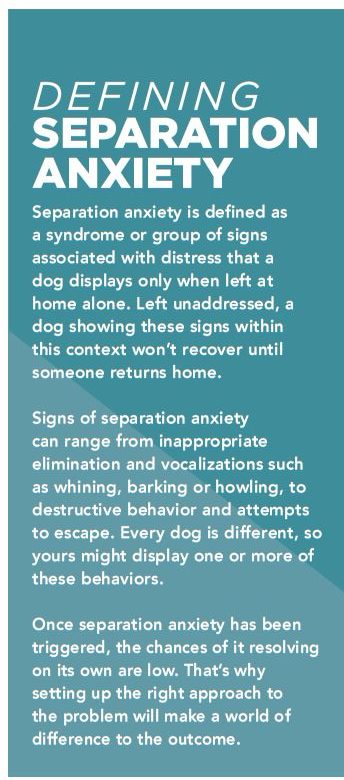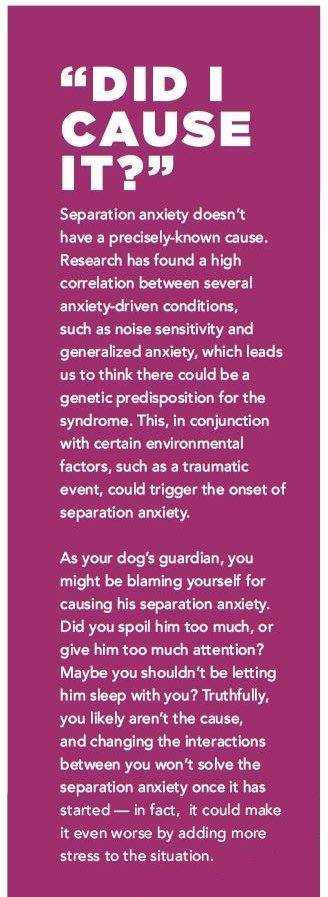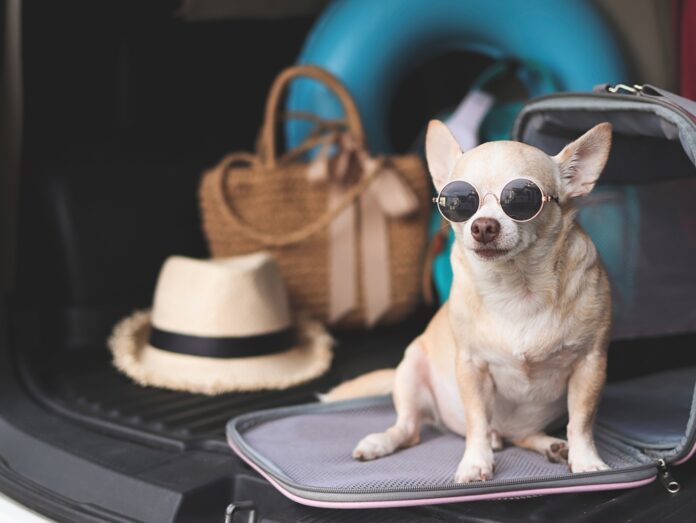Does your dog have separation anxiety?

Separation anxiety is common in canines, but don’t despair. Follow these four important steps to a calmer, more relaxed dog.
Separation anxiety in dogs is both heartbreaking and challenging. Knowing that your dog is so stressed by being left alone that he’ll cry all day, destroy furnishings, or scratch the door to pieces, is hard to bear. However, this is a common issue, and the good news is that there are ways to overcome it and help you dog feel calmer and happier when you have to leave him at home on his own.
 4 steps to solving separation anxiety in your dog
4 steps to solving separation anxiety in your dog
1. Make sure it’s separation anxiety
You might think your dog has separation anxiety because your neighbors told you he barks throughout the day while you are out. Or perhaps you came home to find some of your furniture destroyed, or puddles or urine on the floor. While separation anxiety could be the reason behind these issues, other situations might be triggering them.
Observe his body language
This is why observing your dog while alone is a must. It will allow you to see his body language when he’s on his own, and what leads to the appearance of these signs. Setting a device to record him while you leave the house for ten minutes, or using an online camera so you can see what’s going on via your phone, are options for accomplishing this. A dog who is anxious about being alone will show body language that suggests distress – e.g. pacing, shaking, whining, barking, panting, etc. — and once the signs start, they won’t stop until you’re back.
Rule out other issues
Beside this assessment, you will also have to rule out any other issues. Destroying objects can be caused by boredom, for example, while eliminating in inappropriate spots can mean a lack of housetraining. Periodic barking can be caused by outside stimuli. Dogs can also have confinement issues (if left in restricted areas), noise sensitivities, or physical health issues that cause stress. In other words, there are many reasons why a dog could be displaying these signs.
We can’t successfully teach a dog not to be afraid of a stimulus if we’re always exposing him to it at levels that trigger him.
Taking your dog to the vet to make sure he’s healthy is an important first step. Once physical problems are ruled out, consult with a behavior consultant who can compile a history of your dog’s behaviors, complement what you found during your dog’s “alone time assessment”, and help you determine what is really going on. Once you know for sure what the problem is, you can start helping your dog feel better.
2. Consider medications and/or holistic therapies
Once you know your dog has separation anxiety, you’ll need to address three main aspects in order to help him. The first is to consider the potential need for medication or natural supplements to help him calm down.
Conventional meds
While conventional medication should be a last resort, some dogs do benefit from it while you work on the other aspects of alleviating anxiety. There’s a high correlation among different anxiety-driven conditions, which suggests a chemical imbalance may exist in dogs who suffer from one or more of these issues. Correcting this imbalance with the right medication can help these dogs cope with life, and respond better to the behavior modification plan (more on this below).
 Alternative therapies
Alternative therapies
Keep in mind that natural supplements, herbs or homeopathy can also be very effective at relieving your dog’s anxiety at being left alone. Consult with a holistic or integrative veterinarian, who is also knowledgeable about behavior medicine, to find the right solution for your dog.
3. Manage your absences during the training process
If you have a dog with separation anxiety, you are probably already doing whatever you can not to leave him alone more than necessary. But you’ll need to go a step further by managing all of your absences for a while. Being creative and organized can help you achieve this more easily than you think, even if you have busy life.
It doesn’t mean you have to be with your dog 24/7. But it does mean he’ll have to be with another person at all times, whether in your home, or someplace else where he feels comfortable. Some solutions include:
- Taking him to a trusted dog daycare
- Hiring a pet sitter
- Enlisting a friend or family member who can have your dog at her home a few days a week
- Taking your dog to work with you (if your workplace allows it)
- Working from home.
Mixing and matching these various options will help you cover every day and hour of the week.
This may seem like a lot of hassle, but there’s a reason for doing it. We can’t successfully teach a dog not to be afraid of a stimulus if we’re always exposing him to it at levels that trigger him. For example, if we want to overcome a phobia of spiders, we not only have to work on it slowly, but we have to avoid being exposed to spiders at a level we can’t handle; otherwise, we can’t desensitize (adapt) to whatever is causing our fear (in this case, spiders). It’s like trying to get the water out of a sinking boat without first fixing the hole in the bottom — we can try all we want but the boat will eventually sink.
4. Engage your dog in a behavior modification program
It’s important to engage the services of a dog trainer or canine behaviorist who will help you develop a behavior modification program. This program will be based on a desensitization protocol, and designed to guide and coach you through daily training sessions. These sessions seek to desensitize your dog to your departure and absence, and include several steps to help him adjust to your exit in a relaxed manner. The trainer or behaviorist will give you the guidance, support and coaching you need during this process to maximize your chances of success.
All this can be done from the comfort of your own home. In fact, a remote approach on the part of the trainer or behaviorist works best when dealing with separation anxiety because it allows him/her to make a more accurate real-life assessment of the problem, and thereby develop a more realistic training scenario.




